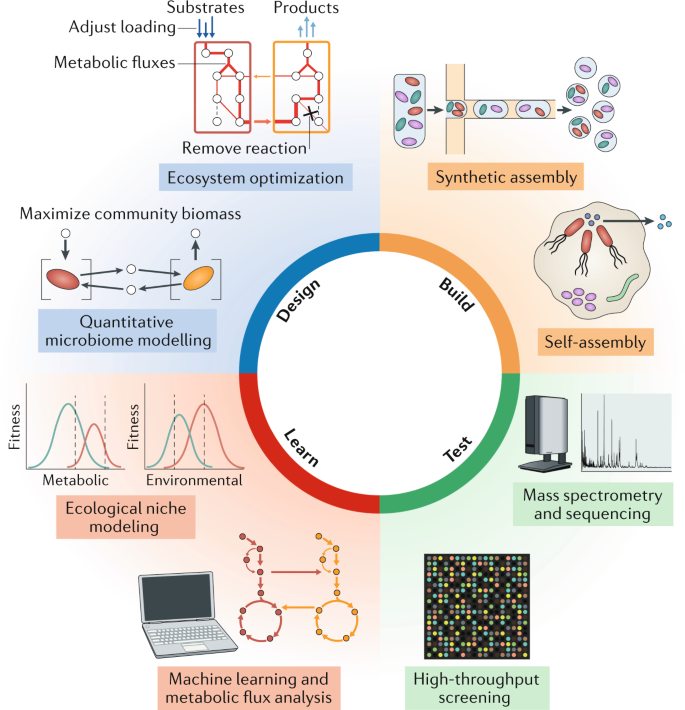Society has enormous potential to recover renewable bioenergy and bioproducts from waste streams, while simultaneously reducing waste disposal impacts and our dependance on fossil fuels. Unlocking this potential will require bioengineering innovation to commoditize renewable energy, chemicals, and materials from waste streams at industrial scales. Revolutionary advances in systems and synthetic biology are positioned to make these innovations possible, as breakthroughs in metagenomic sequencing, high-resolution mass spectrometry, and genome editing have opened a window into the metabolic and regulatory networks driving microbial community (“microbiome”) functions, extending from single genes to whole ecosystems. However, incorporating these developments into biotechnologies at scale has been limited by the high complexity of microbe-microbe interactions and the lack of tools to manipulate microbiome assembly and function in a precise manner.
The Microbiome Engineering Lab seeks to create novel anaerobic biotechnologies that recover valuable resources (energy, chemicals, materials) from waste streams using systems and synthetic biology approaches. This will enable a fundamental understanding of microbiome assembly and function and contribute transformative wastewater treatment and solid waste management technologies aimed at building a circular bioeconomy.
Systematic engineering of microbiomes for resource recovery
Our lab is devoted to creating new microbiome engineering approaches to recover a wider range of high-value bioproducts from wastes. While microbiome engineering has traditionally relied on selection (e.g. manipulation of environmental variables) to steer biological processes towards a desired function, this approach results in highly complex communities that offer little control over the specific products that can be made. We are developing high-throughput methods that integrate automation, synthetic biology, and machine learning to create engineered microbiomes that recover a broad range of bioproducts from waste streams at commercially viable titers, rates, and yields. Our main objectives in this area are: 1) systematic assembly and analysis of synthetic anaerobic microbiomes to produce valuable chemicals and 2) metabolic engineering of diverse non-model anaerobic microorganisms to optimize flux through microbiome metabolic networks.

Metabolic regulation of anaerobic microbiome metabolism
Despite decades of investigations into anaerobic microbiome metabolism, our ability to predict the interwoven metabolic networks driving organic matter conversion to bioproducts remains insufficient for bioengineering. This is because existing approaches fail to establish quantitative and causal links between feedstock chemistry, process rates and conditions, and in situ activity (i.e. fluxes) of microbiome metabolic networks. This makes it challenging to accelerate process reaction rates, maximize bioproduct yields, predict process stability, and assess process performance under different operational strategies in a rational manner. Our lab will focus on the systems-level analysis of metabolic regulation in anaerobic microbiomes and associated anaerobic microorganisms involved in converting wastes into bioproducts, using state-of-the-art metabolomic and metaproteomic approaches coupled to isotope tracing and quantitative metabolic modeling. Our main research objectives in this area are: 1) quantitative understanding of microbiome metabolism remodeling during different feeding and operational strategies, 2) metabolic regulation in non-model anaerobic microorganisms involved in waste deconstruction and conversion, and 3) elucidating metabolic interactions and fluxes in anaerobic microbiomes.
